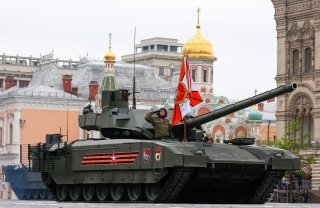Is Russia Already Looking for a Armata T-14 Tank Replacement?
Because of the high costs, Russia has been unable to produce as many of the tanks as it originally planned and has sought to find foreign buyers to help subsidize the costs.
The Russian-built T-14 Armata has been praised as one of the most advanced main battle tanks (MBT) being fielded today, but by other accounts is an overly expensive platform that hasn’t lived up to the hype with at least one reportedly being destroyed all too easily while being field-tested in Syria.
The Armata T-14 MBT was first demonstrated during the May 2015 Victory Parade in Moscow, and despite a reduction in Russian defense spending that came with lower oil prices earlier this year, the Russian military has continued with the production of the new tank. It is being overseen by Rostec Corporation, the Moscow conglomerate that specializes in consolidating strategically important companies in Russia’s defense sector. Because of the high costs, Russia has been unable to produce as many of the tanks as it originally planned and has sought to find foreign buyers to help subsidize the costs.
Russia’s Industry and Trade Minister Denis Manturov earlier this year said that Russia was planning to start work with foreign customers of the Armata tank in 2021 and had already received several prior requests.
While it was announced this week that a completely unmanned version of the T-14 might be in the works, Russian military planners are now reportedly thinking ahead to what comes after the Armata program. The concept of a two-section “tank of the future” designed to replace the latest Armata armored vehicle after the 2040s was presented this week at the Army-2020 International Military and Technical Forum.
Specialists from the 38th R&D and Testing Institute of Armored Hardware and Armament, which drafts requirements for advanced armor, said they believe that while the Armata tank and its variants will be effective on the battlefield until at least the 2040s, it is necessary to lay the groundwork for a tank of the “distant” future.
“Specialists of the 38th Institute today perceive such a combat vehicle in the option of a coupled two-section design,” Institute Deputy Chief Colonel Yevgeny Gubanov told Tass on Tuesday. “The front combat module may have a control compartment with three crewmembers in a highly protected armored capsule. The module’s medium part is expected to accommodate an unmanned turret with a mounted electro-thermochemical cannon with an automatic loader.”
Sectional Tank
The tank’s front module would be outfitted with reactive armor, feature a “blinding laser weapon” and an electromagnetic pulse generator as its primary defense. The module’s rear area would accommodate vertical take-off homing missiles with an operating range of up to twelve kilometers.
Russian designers have also promoted the idea that this future tank would be armed with an electro-thermochemical cannon that would utilize new compounds instead of the traditional gunpowder and it could be ignited by an electric discharge while it could fire hypersonic shells.
This future tank’s second section, which would be coupled with the first, could be expected to accommodate a three-thousand horsepower multi-fuel gas turbine engine. The second module would also carry air and ground drones to conduct reconnaissance, search for mines and perform other general security functions.
The Russian Institute's specialists also suggested that a further build-up of the platform’s firepower and armor within the existing configurations would considerably increase the mass. The coupling of two sections, however, would help reduce specific ground pressure and solve the problem of creating a tank that is far too heavy to move over soft ground—so perhaps the engineers have studied the problems that came with the pre-World War I era “Tzar tank!”
Moreover, the experts at the Institute said that they believe the tank’s general-purpose engine compartment could be used together with manned modules for motor rifle personnel as well as with specialized combat modules, which could provide armament of various calibers and designations.
There was also discussion of how the tank’s crew could be provided with combat and situational awareness with the help of the “transparent armor” vision technology where information and other data could be provided via various external sensors that is transmitted to the crew inside the armored capsule.
If there is an outstanding question left to be answered, then it is what this “tank of the future” might cost and then whether Russia could ever possibly afford to field these armored beasts in significant numbers.
Peter Suciu is a Michigan-based writer who has contributed to more than four dozen magazines, newspapers and websites. He is the author of several books on military headgear including A Gallery of Military Headdress, which is available on Amazon.com.
Image: Reuters

